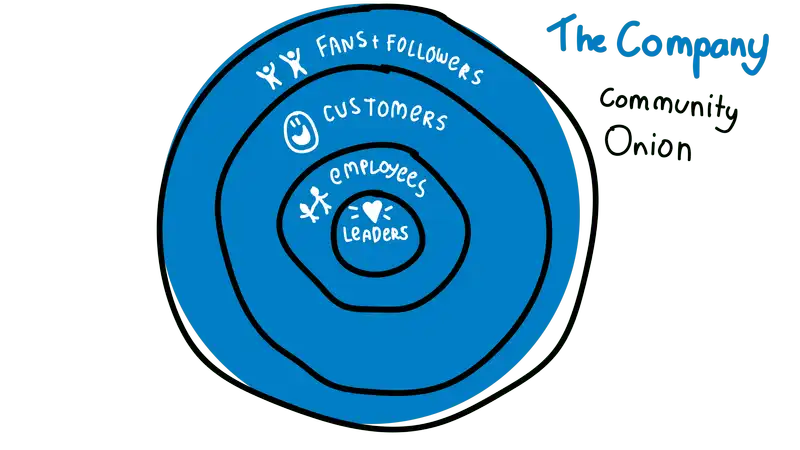The purpose of this activity is to assign layers of responsibility and align purpose for every team member involved.

The community onion is focused on the four levels of project participation, determined by whether a team member is making strategic, tactical, operational or user decisions. This activity ensures that those at the core of the onion who are most invested in making the change, are aligned on the mission and the vision of the project.
Once this is established, its purpose is to empower the project leaders and influencers to plan how the project will take shape. When these key stakeholders understand and believe in the mission, and have influence over the project scope and resources, they are more willing to commit to a product roadmap. They essentially become project ambassadors for the operational team members who are responsible for what actually gets built.With full visibility as to why it is happening in the first place and how it is going to happen, the main project team is empowered to create exactly what the end-user requires and rally their support for the final solution.
Two-way communication between the end-user and all levels of decision-making is important throughout the project, in order to create the technical and cultural shift that ultimately results in finding the right software/people fit.
Before you start
The person responsible for instigating the project needs to understand the mission, vision and values that will underpin the project as it currently stands and bring these to the first session.
Details
Level of difficulty
Easy
Stage
Prepare
Suggested time
Around 2 hours, plus regular ceremonies for each layer to ensure alignment and delivery of the project.
Participants
- Product owner
- Business Analyst
- Squad lead
- Designer
- Web engineer
- Test engineer
- Account manager
- Stakeholders
- Users
Materials
- Whiteboard
- An org chart
- Open minds and commitment to the mission.
Steps
- Bring together the inner core of the community onion - the strategic decision makers of the project (i.e. the CEO, CTO or CIO). Gain consensus on the vision and mission of the project by focusing on the why.
- Take the project leaders on the journey by bringing together the next layers of the onion: the tactical decision makers (i.e. Product Owner, Business Analyst and Squad Lead). Share the vision and mission of the project and empower the leaders and influencers to decide and commit to the scope and the resources required for a successful project.
- Now it’s time to bring the wider project team on the journey by involving the operational decision makers (i.e. engineers, designers, and account managers). Share the project mission, vision, resources, and scope, and invite them to contribute to the form and function of the project by prioritising what needs to happen to achieve the project goals within the agreed timeframe.
- Step 4 happens concurrently with steps 1, 2 and 3 and is critical to ensure internal adoption of the project. It involves two-way communication with the end-users of the product, sharing the vision, mission, scope and function of the project as well as understanding the cultural context, motivations and processes that currently exist.
Justification
This activity is a combination of three different concepts applied specifically to a software migration project. The Community Onion is a conceptual framework used to think about the different kinds of membership a community can have. It is based on the idea that those at the centre have the highest level of commitment and contribution to the community.
Modern military theory divides war into strategic, operational, and tactical levels and we use these same definitions to define decisions made at different levels in an organisation’s hierarchy. Strategic decisions are long-term in their impact and they shape the direction of the whole business (for example, the priority and timing of when a particular migration project should happen). They are generally made by senior executives. Tactical decisions help to implement the strategy and are usually made by project leaders or middle management. Operational decisions that relate to the day-to-day running of the project and are mainly made by team leaders or members.




